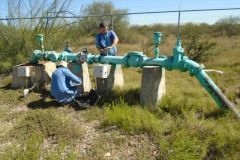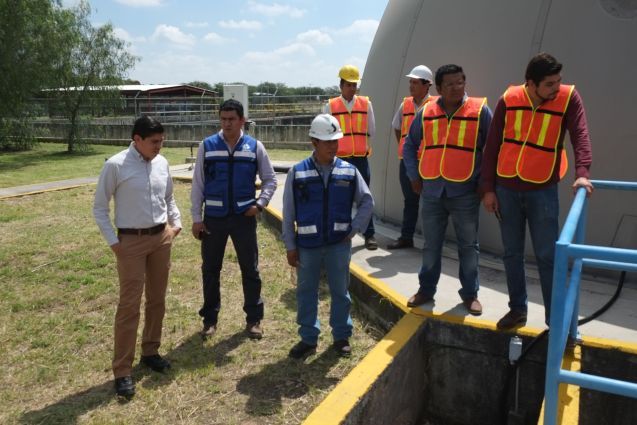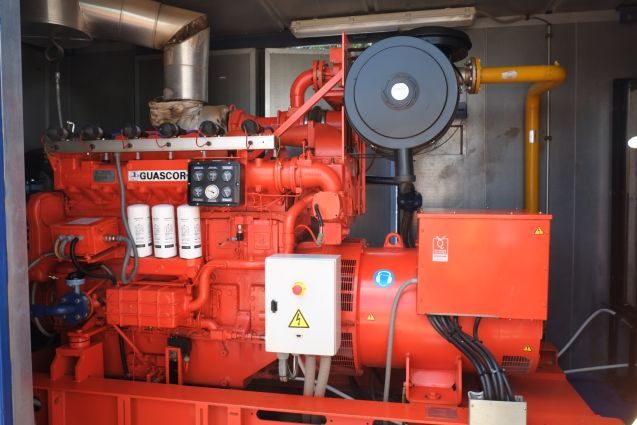Between 2014 and 2018, two water utilities in the municipalities of San Francisco del Rincón and Purísima del Rincón in the state of Guanajuato, Mexico, participated in an innovative pilot project aimed at reducing greenhouse gas (GHG) emissions through improved efficiency of water and wastewater treatment services.

Mexico’s urban water cycle contributes up to 5% of the total GHG emissions in the country. To reduce their emissions, and lower costs at the same time, the two utilities pioneered implementation of the Roadmap to a Low-Carbon Urban Water Utility in Mexico. The Drinking Water and Sewerage System of San Francisco (SAPAF) operates the utility responsible for the water supply and sewage collection in San Francisco del Rincón, while the Wastewater Treatment and Disposal Service (SITRATA) operates the wastewater treatment plant (WWTP) shared by the two municipalities. The roadmap was developed by the Water and Wastewater Companies for Climate Mitigation (WaCCliM) project, a joint initiative of the Deutsche Gesellschaft für Internationale Zusammenarbeit (GIZ) GmbH and the International Water Association (IWA). It focuses on climate mitigation and awareness raising to help ensure that water utilities not only adapt to the consequences of climate change, but also play an active role in reducing their carbon footprints.

As part of the roadmap, an initial baseline assessment of the two utilities identified untreated wastewater as the main source of GHG emissions in the urban water cycle. Consequently, SAPAF constructed collectors to increase the wastewater treatment coverage. This reduced emissions from CO₂-eq by 2,500 tons per year, which equals the annual emissions of 830 compact cars and represents a 40% decrease in the total emissions in the utilities’ operating areas.
The increased wastewater received by the common wastewater treatment plant posed a new challenge to SITRATA, which had to treat a larger volume without access to additional funds. To overcome this problem, the utility focused on two objectives: optimizing the aeration process and improving biogas production to generate electricity for internal consumption. Thanks to its efforts, SITRATA reduced the energy consumption per cubic meter treated by approximately 10%; it also produces 155,000 kWh annually through its cogeneration system using the methane generated in the anaerobic sludge digestion process, with work ongoing to increase this amount.

Following the lead of SAPAF and SITRATA, the Municipal System of Drinking Water and Sewerage of Moroleón (SMAPAM) in Guanajuato has also started to implement the WaCCliM approach. Efficiency measures in the water supply system have already reduced the electricity SMAPAM consumes for pumping by 6%. The measures included the replacement of the least efficient pumps in the system and the implementation of programs to reduce the local population’s water consumption, which led to less pumped water and, as a result, water and energy conservation. The next step for the utility is to identify and reduce water losses in the distribution system, which are directly related to high energy consumption. WaCCliM is supporting the analysis of water losses and modeling of the distribution network.
In the neighboring state of Querétaro, assessment studies on pumping stations supported by the WaCCliM project have led the State Water Commission of Querétaro to allocate two million pesos (approximately 100,000 EUR) for implementation measures that enhance the efficiency of the pumping stations. In Parral, Chihuahua, in northern Mexico, the utility has also showed great interest in the WaCCliM approach. After an initial energy performance evaluation supported by the WaCCliM project and the renovation of some of its equipment, the utility is funding additional studies on its own, including distribution network modeling and the identification of optimization points in the operating system.
These success stories in Mexico will encourage other water and wastewater utilities to contribute to climate change mitigation while improving service levels and reducing operational costs.
The number of cars was determined using the emission factor of CO₂ (g/km) per car model, assuming that a car travels a total of 15,000 km per year. A mean emission value of nearly three tons/car per year was calculated. See http://www.ecovehiculos.gob.mx/ecovehiculos/ (in Spanish).
